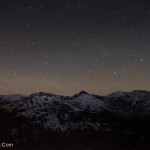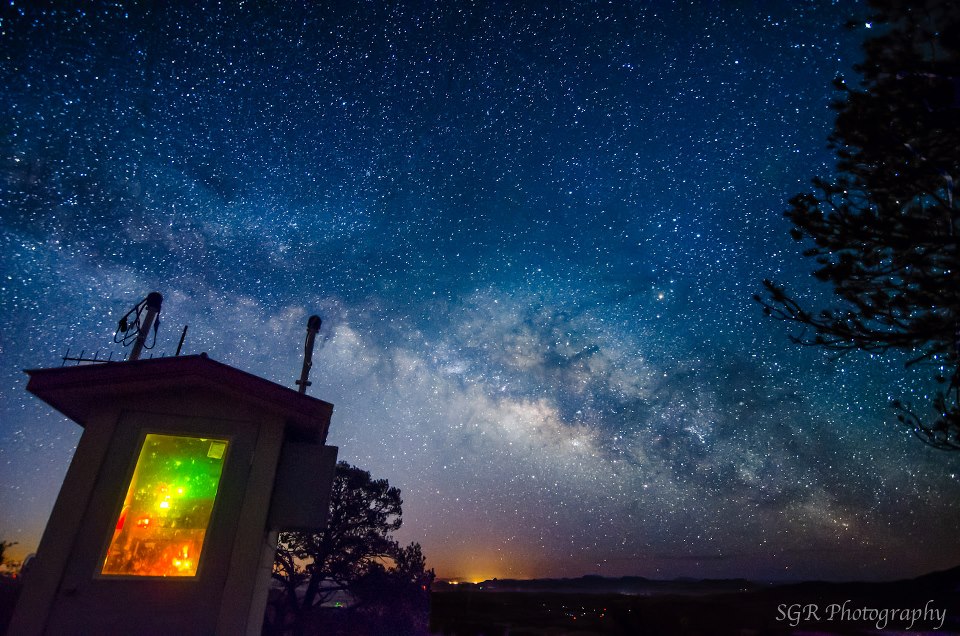
Suppose you had a clear, moonless night. How many stars could you see with the eye alone?
There’s really no definitive answer to this question. No one has counted all the stars in the night sky, and astronomers use different numbers as theoretical estimates.
Considering all the stars visible in all directions around Earth, the upper end on the estimates seems to be about 10,000 visible stars. Other estimates place the number of stars visible to the eye alone – surrounding the entire Earth – at more like 5,000. At any given time, half of Earth is in daylight. So only half the estimated number – say, between 5,000 and 2,500 stars – would be visible from Earth’s night side.
Plus, another fraction of those visible stars would be lost in the haze all around your horizon.

Stars over Mount Bethel in the Arapaho National Forest in Colorado. View larger. via EarthSky friend Daniel McVey. See more of Daniel’s photos here.
Why can’t astronomers agree on the number of visible stars? It’s because we don’t all see the sky in the same way. Even under ideal conditions, there’s a fair amount of variation between how well people can see the stars – depending on things like the strength of your vision – and your age. As you get older, for example, your eyes become much less sensitive to faint light.
You also have to take into account the brightness of your night sky. Even on a moonless night, the glow of lights from Earth’s surface brightens the sky.
Still – far from city lights – under absolutely perfect conditions of darkness and sky clarity – a young to middle-aged person with normal vision should be able to see thousands of stars.

‘A nice west Texas sky from Mt. Locke, in the Davis mountains near the McDonald Observatory … Even from this remote location, you can see the light coming from Fort Davis on the bottom of the image.’ by EarthSky Facebook friend Sergio Garcia Rill
Visit the International Dark-sky Association
What Major World Cities Look Like at Night, Minus the Light Pollution
from EarthSky http://earthsky.org/space/how-many-stars-could-you-see-on-a-clear-moonless-night

Suppose you had a clear, moonless night. How many stars could you see with the eye alone?
There’s really no definitive answer to this question. No one has counted all the stars in the night sky, and astronomers use different numbers as theoretical estimates.
Considering all the stars visible in all directions around Earth, the upper end on the estimates seems to be about 10,000 visible stars. Other estimates place the number of stars visible to the eye alone – surrounding the entire Earth – at more like 5,000. At any given time, half of Earth is in daylight. So only half the estimated number – say, between 5,000 and 2,500 stars – would be visible from Earth’s night side.
Plus, another fraction of those visible stars would be lost in the haze all around your horizon.

Stars over Mount Bethel in the Arapaho National Forest in Colorado. View larger. via EarthSky friend Daniel McVey. See more of Daniel’s photos here.
Why can’t astronomers agree on the number of visible stars? It’s because we don’t all see the sky in the same way. Even under ideal conditions, there’s a fair amount of variation between how well people can see the stars – depending on things like the strength of your vision – and your age. As you get older, for example, your eyes become much less sensitive to faint light.
You also have to take into account the brightness of your night sky. Even on a moonless night, the glow of lights from Earth’s surface brightens the sky.
Still – far from city lights – under absolutely perfect conditions of darkness and sky clarity – a young to middle-aged person with normal vision should be able to see thousands of stars.

‘A nice west Texas sky from Mt. Locke, in the Davis mountains near the McDonald Observatory … Even from this remote location, you can see the light coming from Fort Davis on the bottom of the image.’ by EarthSky Facebook friend Sergio Garcia Rill
Visit the International Dark-sky Association
What Major World Cities Look Like at Night, Minus the Light Pollution
from EarthSky http://earthsky.org/space/how-many-stars-could-you-see-on-a-clear-moonless-night

Aucun commentaire:
Enregistrer un commentaire